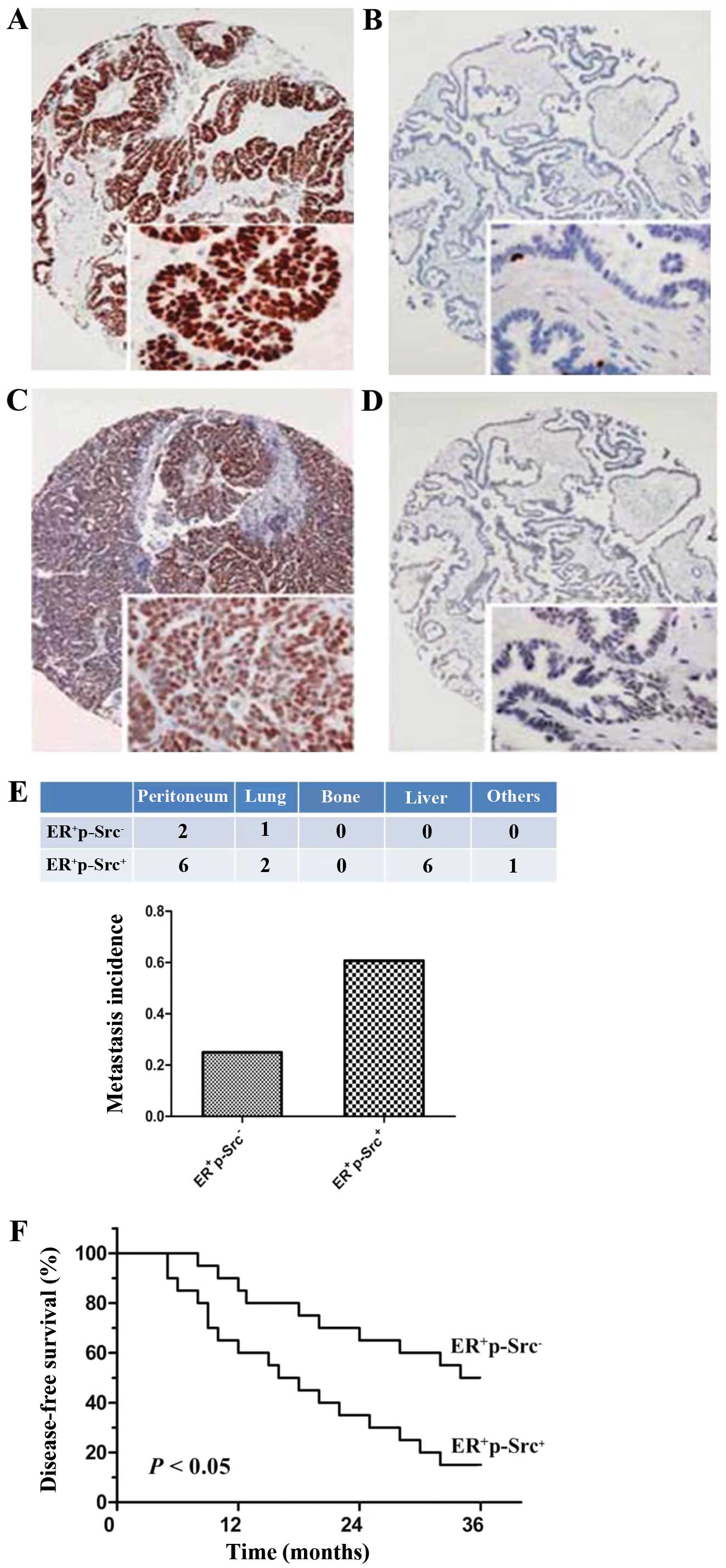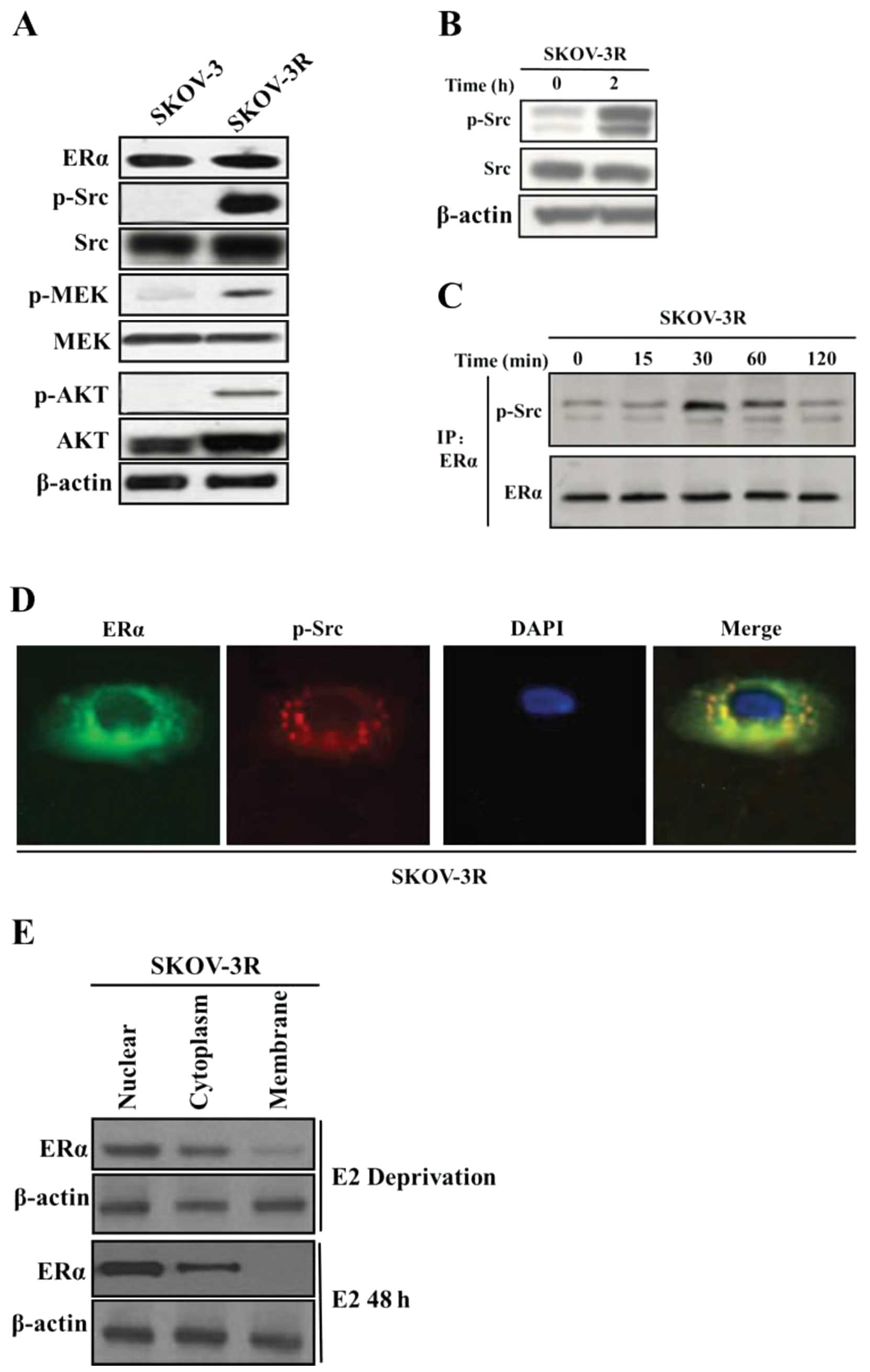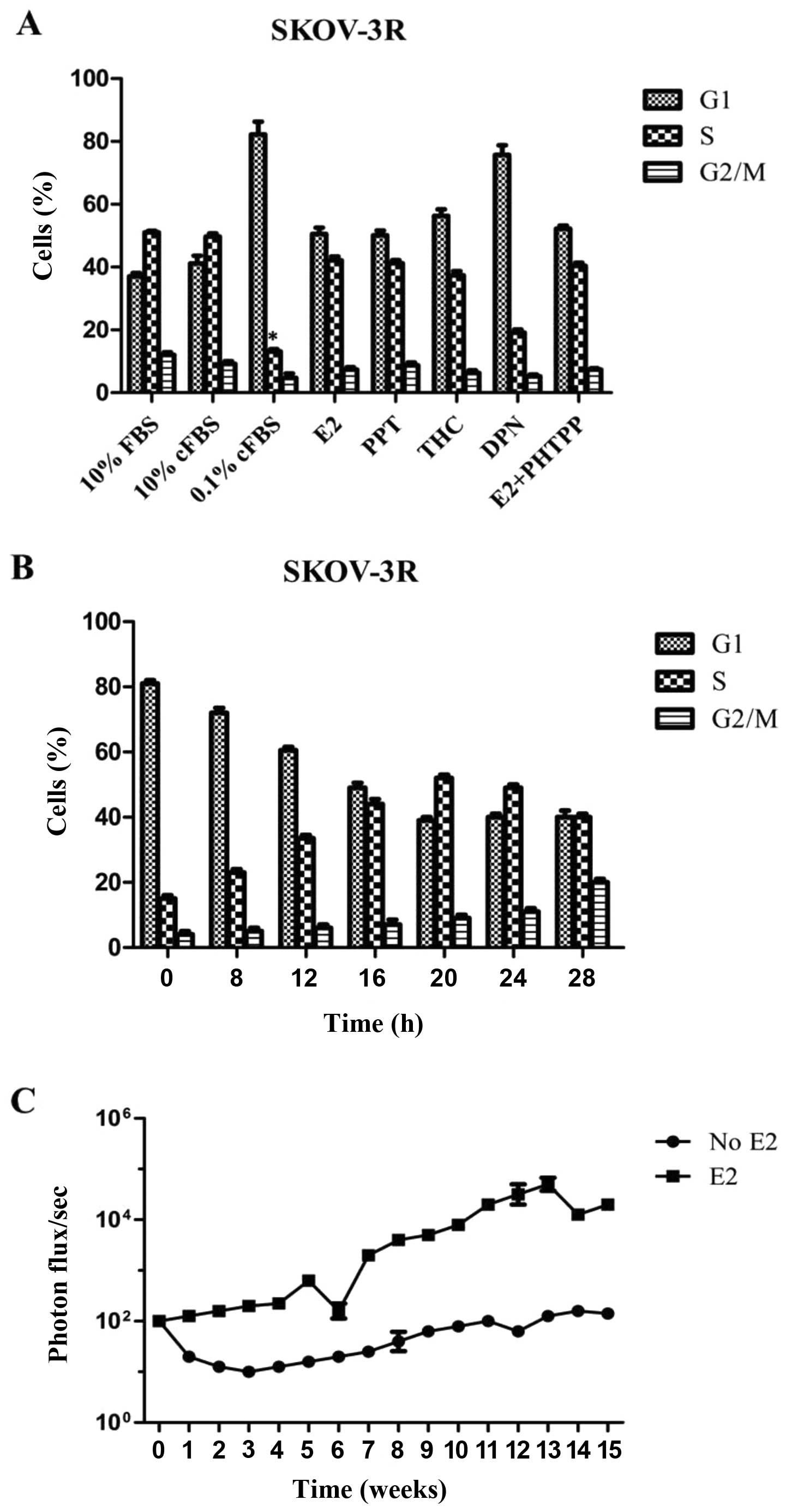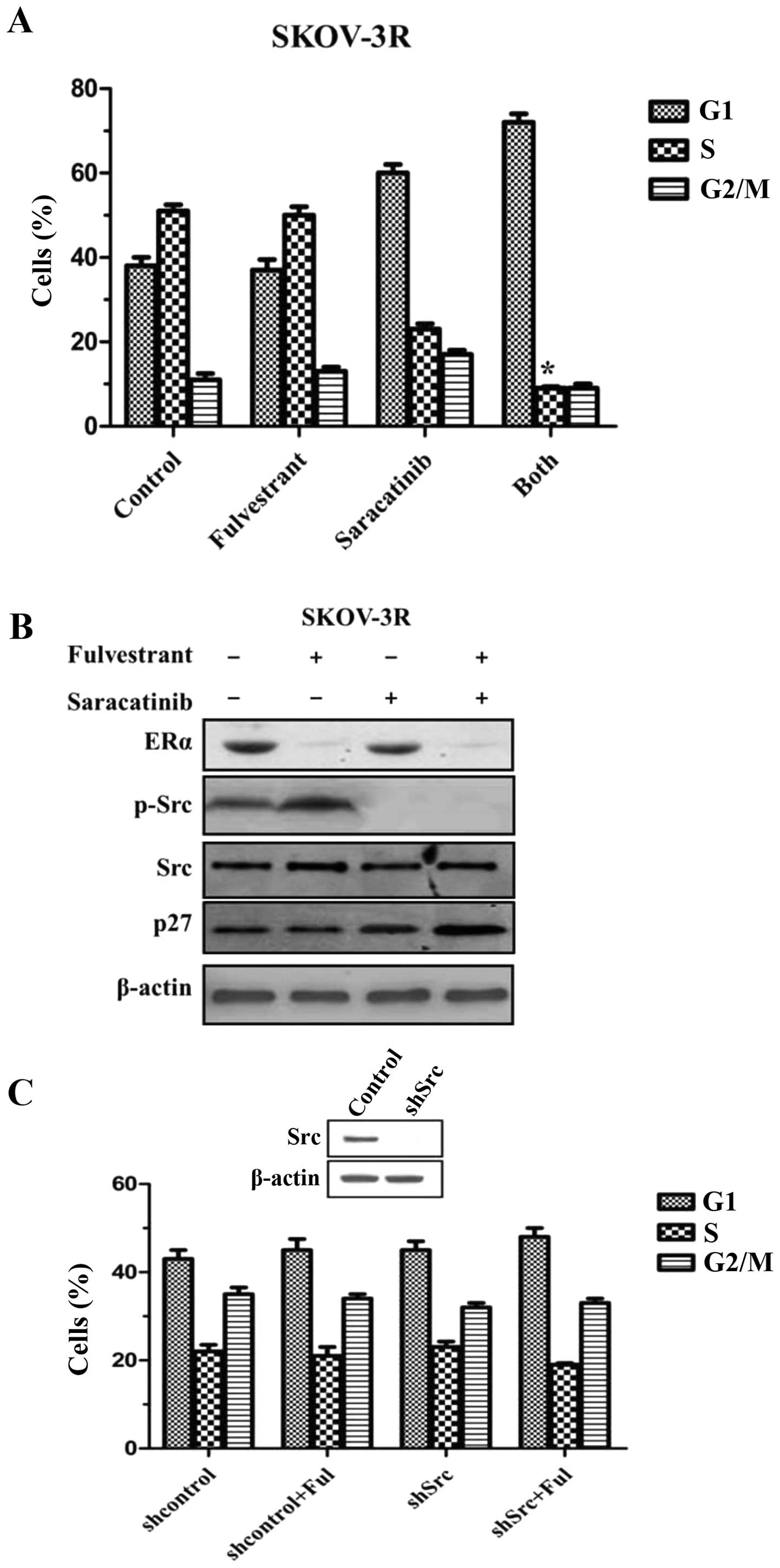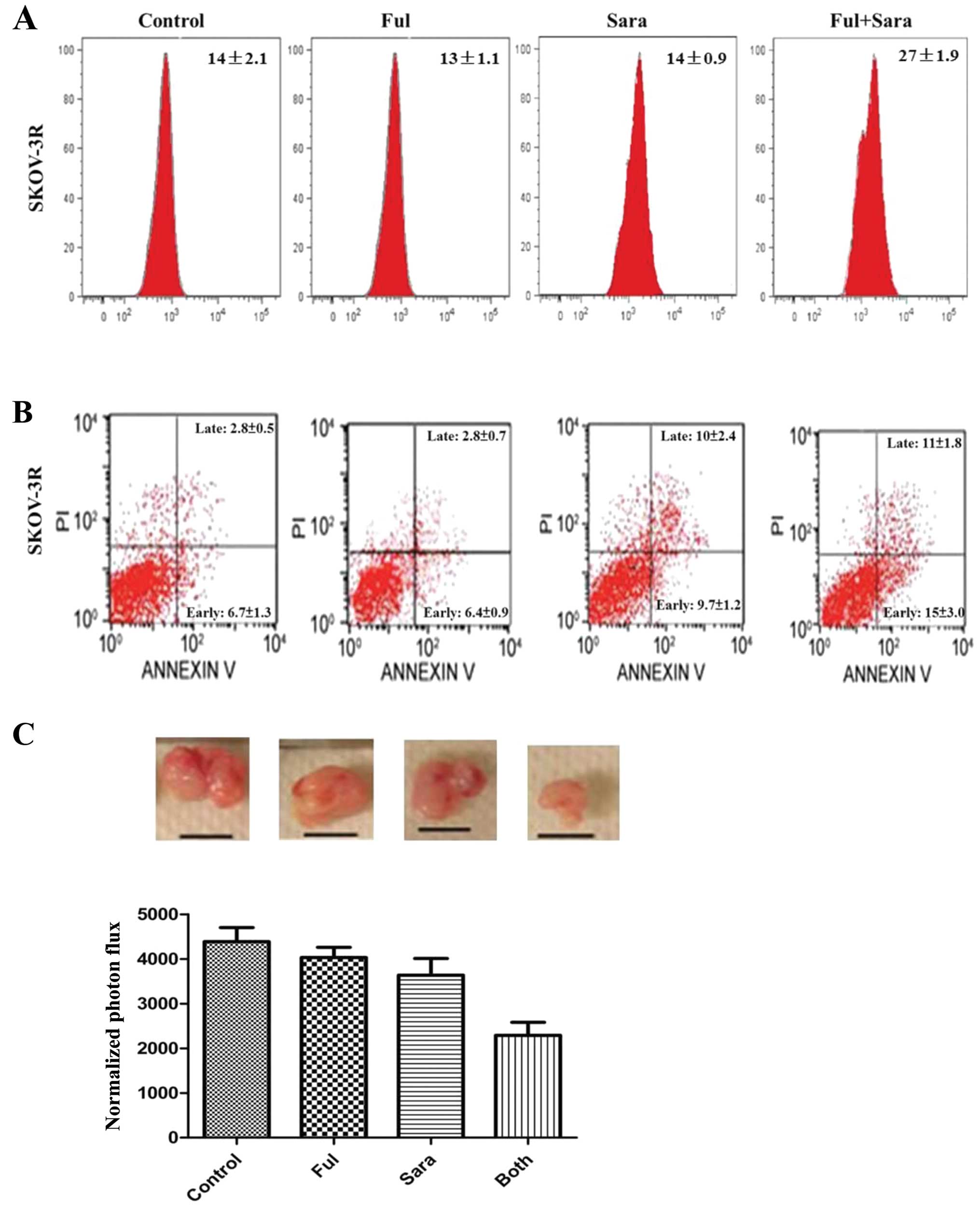|
1
|
Siegel R, Naishadham D and Jemal A: Cancer
statistics, 2013. CA Cancer J Clin. 63:11–30. 2013. View Article : Google Scholar
|
|
2
|
Siegel R, Naishadham D and Jemal A: Cancer
statistics, 2012. CA Cancer J Clin. 62:10–29. 2012. View Article : Google Scholar
|
|
3
|
Simpkins F, Hevia-Paez P, Sun J, et al:
Src inhibition with saracatinib reverses fulvestrant resistance in
ER-positive ovarian cancer models in vitro and in vivo. Clin Cancer
Res. 18:5911–5923. 2012. View Article : Google Scholar : PubMed/NCBI
|
|
4
|
Argenta PA, Um I, Kay C, et al: Predicting
response to the anti-estrogen fulvestrant in recurrent ovarian
cancer. Gynecol Oncol. 131:368–373. 2013. View Article : Google Scholar : PubMed/NCBI
|
|
5
|
Badia E, Docquier A, Busson M, et al:
Long-term treatment with the pure anti-estrogen fulvestrant durably
remodels estrogen signaling in BG-1 ovarian cancer cells. J Steroid
Biochem Mol Biol. 132:176–185. 2012. View Article : Google Scholar : PubMed/NCBI
|
|
6
|
Bossard C, Busson M, Vindrieux D, et al:
Potential role of estrogen receptor beta as a tumor suppressor of
epithelial ovarian cancer. PLoS One. 7:e447872012. View Article : Google Scholar : PubMed/NCBI
|
|
7
|
Halon A, Materna V, Drag-Zalesinska M, et
al: Estrogen receptor alpha expression in ovarian cancer predicts
longer overall survival. Pathol Oncol Res. 17:511–518. 2011.
View Article : Google Scholar : PubMed/NCBI
|
|
8
|
Kothari R, Argenta P, Fowler J, Carter J
and Shimp W: Antiestrogen therapy in recurrent ovarian cancer
resulting in 28 months of stable disease: a case report and review
of the literature. Arch Oncol. 18:32–35. 2010. View Article : Google Scholar : PubMed/NCBI
|
|
9
|
Smyth JF, Gourley C, Walker G, et al:
Antiestrogen therapy is active in selected ovarian cancer cases:
the use of letrozole in estrogen receptor-positive patients. Clin
Cancer Res. 13:3617–3622. 2007. View Article : Google Scholar : PubMed/NCBI
|
|
10
|
Park MA, Hwang KA, Lee HR, Yi BR, Jeung EB
and Choi KC: Benzophenone-1 stimulated the growth of BG-1 ovarian
cancer cells by cell cycle regulation via an estrogen receptor
alpha-mediated signaling pathway in cellular and xenograft mouse
models. Toxicology. 305:41–48. 2013. View Article : Google Scholar
|
|
11
|
Wang L, Wang G, Yang D, et al: Euphol
arrests breast cancer cells at the G1 phase through the modulation
of cyclin D1, p21 and p27 expression. Mol Med Rep. 8:1279–1285.
2013.PubMed/NCBI
|
|
12
|
Jiang D, Wang X, Liu X and Li F: Gene
delivery of cyclin-dependent kinase inhibitors
p21Waf1 and p27Kip1 suppresses
proliferation of MCF-7 breast cancer cells in vitro. Breast Cancer.
2013.[Epub ahead of print].
|
|
13
|
Psyrri A, Bamias A, Yu Z, et al:
Subcellular localization and protein levels of cyclin-dependent
kinase inhibitor p27 independently predict for survival in
epithelial ovarian cancer. Clin Cancer Res. 11:8384–8390. 2005.
View Article : Google Scholar
|
|
14
|
Hurteau JA, Allison BM, Brutkiewicz SA, et
al: Expression and subcellular localization of the cyclin-dependent
kinase inhibitor p27Kip1 in epithelial ovarian cancer.
Gynecol Oncol. 83:292–298. 2001. View Article : Google Scholar : PubMed/NCBI
|
|
15
|
Xing D and Orsulic S: A genetically
defined mouse ovarian carcinoma model for the molecular
characterization of pathway-targeted therapy and tumor resistance.
Proc Natl Acad Sci USA. 102:6936–6941. 2005. View Article : Google Scholar : PubMed/NCBI
|
|
16
|
Integrated genomic analyses of ovarian
carcinoma. Nature. 474:609–615. 2011. View Article : Google Scholar
|
|
17
|
Huang YW, Chen C, Xu MM, Li JD, Xiao J and
Zhu XF: Expression of c-Src and phospho-Src in epithelial ovarian
carcinoma. Mol Cell Biochem. 376:73–79. 2013. View Article : Google Scholar : PubMed/NCBI
|
|
18
|
Kim HS, Han HD, Armaiz-Pena GN, et al:
Functional roles of Src and Fgr in ovarian carcinoma.
Clin Cancer Res. 17:1713–1721. 2011.
|
|
19
|
Matsuo K, Nishimura M, Bottsford-Miller
JN, et al: Targeting SRC in mucinous ovarian carcinoma. Clin Cancer
Res. 17:5367–5378. 2011. View Article : Google Scholar : PubMed/NCBI
|
|
20
|
Zhao Y, Li X, Sun X, Zhang Y and Ren H:
EMT phenotype is induced by increased Src kinase activity via
Src-mediated caspase-8 phosphorylation. Cell Physiol Biochem.
29:341–352. 2012. View Article : Google Scholar : PubMed/NCBI
|
|
21
|
Castoria G, Giovannelli P, Lombardi M, et
al: Tyrosine phosphorylation of estradiol receptor by Src regulates
its hormone-dependent nuclear export and cell cycle progression in
breast cancer cells. Oncogene. 31:4868–4877. 2012. View Article : Google Scholar : PubMed/NCBI
|
|
22
|
Chu I, Sun J, Arnaout A, et al: p27
phosphorylation by Src regulates inhibition of cyclin E-Cdk2. Cell.
128:281–294. 2007. View Article : Google Scholar : PubMed/NCBI
|
|
23
|
Serkies K, Sinacki M and Jassem J: The
role of hormonal factors and endocrine therapy in ovarian cancer.
Contemp Oncol. 17:14–19. 2013.PubMed/NCBI
|
|
24
|
Brenton JD and Stingl J: Stem cells:
anatomy of an ovarian cancer. Nature. 495:183–184. 2013. View Article : Google Scholar : PubMed/NCBI
|
|
25
|
Coates AS, Keshaviah A, Thürlimann B, et
al: Five years of letrozole compared with tamoxifen as initial
adjuvant therapy for postmenopausal women with endocrine-responsive
early breast cancer: update of study BIG 1–98. J Clin Oncol.
25:486–492. 2007.PubMed/NCBI
|
|
26
|
Regan MM, Neven P, Giobbie-Hurder A, et
al: Assessment of letrozole and tamoxifen alone and in sequence for
postmenopausal women with steroid hormone receptor-positive breast
cancer: the BIG 1–98 randomised clinical trial at 8.1 years median
follow-up. Lancet Oncol. 12:1101–1108. 2011.PubMed/NCBI
|
|
27
|
Jung J, Kim HY, Kim M, Sohn K, Kim M and
Lee K: Translationally controlled tumor protein induces human
breast epithelial cell transformation through the activation of
Src. Oncogene. 30:2264–2274. 2011. View Article : Google Scholar : PubMed/NCBI
|
|
28
|
Hui AY, Meens JA, Schick C, et al: Src and
FAK mediate cell-matrix adhesion-dependent activation of Met during
transformation of breast epithelial cells. J Cell Biochem.
107:1168–1181. 2009. View Article : Google Scholar : PubMed/NCBI
|
|
29
|
Nautiyal J, Yu Y, Aboukameel A, et al:
ErbB-inhibitory protein: a modified ectodomain of epidermal growth
factor receptor synergizes with dasatinib to inhibit growth of
breast cancer cells. Mol Cancer Ther. 9:1503–1514. 2010. View Article : Google Scholar : PubMed/NCBI
|
|
30
|
Moulder S, Yan K, Huang F, et al:
Development of candidate genomic markers to select breast cancer
patients for dasatinib therapy. Mol Cancer Ther. 9:1120–1127. 2010.
View Article : Google Scholar : PubMed/NCBI
|
|
31
|
Gucalp A, Sparano JA, Caravelli J, et al:
Phase II trial of saracatinib (AZD0530), an oral SRC-inhibitor for
the treatment of patients with hormone receptor-negative metastatic
breast cancer. Clin Breast Cancer. 11:306–311. 2011. View Article : Google Scholar : PubMed/NCBI
|
|
32
|
Arcaroli JJ, Touban BM, Tan AC, et al:
Gene array and fluorescence in situ hybridization biomarkers of
activity of saracatinib (AZD0530), a Src inhibitor, in a
preclinical model of colorectal cancer. Clin Cancer Res.
16:4165–4177. 2010. View Article : Google Scholar : PubMed/NCBI
|
|
33
|
Boya P, Reggiori F and Codogno P: Emerging
regulation and functions of autophagy. Nat Cell Biol. 15:713–720.
2013. View Article : Google Scholar : PubMed/NCBI
|
|
34
|
Choi AM, Ryter SW and Levine B: Autophagy
in human health and disease. N Engl J Med. 368:651–662. 2013.
View Article : Google Scholar : PubMed/NCBI
|
|
35
|
Fimia GM, Corazzari M, Antonioli M and
Piacentini M: Ambra1 at the crossroad between autophagy and cell
death. Oncogene. 32:3311–3318. 2013. View Article : Google Scholar : PubMed/NCBI
|















